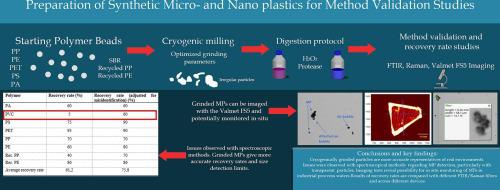当前位置:
X-MOL 学术
›
Sci. Total Environ.
›
论文详情
Our official English website, www.x-mol.net, welcomes your feedback! (Note: you will need to create a separate account there.)
Preparation of synthetic micro- and nano plastics for method validation studies
Science of the Total Environment ( IF 9.8 ) Pub Date : 2024-03-19 , DOI: 10.1016/j.scitotenv.2024.171821 Blaž Hrovat , Emilia Uurasjärvi , Mirka Viitala , Ana Franco del Pino , Mika Mänttäri , Nikolaos Papamatthaiakis , Antti Haapala , Kai Peiponen , Matthieu Roussey , Arto Koistinen
Science of the Total Environment ( IF 9.8 ) Pub Date : 2024-03-19 , DOI: 10.1016/j.scitotenv.2024.171821 Blaž Hrovat , Emilia Uurasjärvi , Mirka Viitala , Ana Franco del Pino , Mika Mänttäri , Nikolaos Papamatthaiakis , Antti Haapala , Kai Peiponen , Matthieu Roussey , Arto Koistinen

|
Microplastic (MP) pollution is a persisting global problem. Accurate analysis is essential in quantifying the effects of microplastic pollution and develop novel technologies that reliably and reproducibly measure microplastic content in various samples. The most common methods for this are FTIR and Raman spectroscopy. Coloured, standardized beads are often used for method validation tests, which limits the conclusions to a very specific case rarely observed in the natural environment. This study focuses on the preparation of reference micro- and nanoplastics via cryogenic milling and shows their use for FTIR and Raman method validation studies. MPs can now be reproducibly milled from various plastics, offering the advantages of a better representation of MPs in real environment. Moreover, this study highlights issues with the current detection methods, up to now considered as the most reliable ones for MP detection and identification. Such issues, e.g. misidentification, will need to be addressed in the future. Additionally, milled MPs were used in experiments with commercial high-resolution imaging device, enabling a possible in-situ optical detection of microplastics. These experiments represent a step forward in understanding MPs in a water sample and provide a basis for a more accurate detection and identification directly from water, which would considerably reduce the time of analysis.
中文翻译:

用于方法验证研究的合成微米和纳米塑料的制备
微塑料(MP)污染是一个持续存在的全球性问题。准确的分析对于量化微塑料污染的影响以及开发可靠且可重复地测量各种样品中微塑料含量的新技术至关重要。最常见的方法是 FTIR 和拉曼光谱。彩色标准化珠子通常用于方法验证测试,这将结论限制在自然环境中很少观察到的非常具体的情况。本研究重点是通过低温研磨制备参考微米和纳米塑料,并展示它们在 FTIR 和拉曼方法验证研究中的用途。现在可以用各种塑料重复铣削 MP,从而提供在真实环境中更好地代表 MP 的优点。此外,这项研究强调了当前检测方法的问题,迄今为止,这些方法被认为是 MP 检测和识别最可靠的方法。未来需要解决诸如错误识别之类的问题。此外,研磨后的 MP 被用于商业高分辨率成像设备的实验中,使得微塑料的原位光学检测成为可能。这些实验代表了在了解水样中 MP 方面向前迈出的一步,并为直接从水中进行更准确的检测和识别提供了基础,这将大大减少分析时间。
更新日期:2024-03-19
中文翻译:

用于方法验证研究的合成微米和纳米塑料的制备
微塑料(MP)污染是一个持续存在的全球性问题。准确的分析对于量化微塑料污染的影响以及开发可靠且可重复地测量各种样品中微塑料含量的新技术至关重要。最常见的方法是 FTIR 和拉曼光谱。彩色标准化珠子通常用于方法验证测试,这将结论限制在自然环境中很少观察到的非常具体的情况。本研究重点是通过低温研磨制备参考微米和纳米塑料,并展示它们在 FTIR 和拉曼方法验证研究中的用途。现在可以用各种塑料重复铣削 MP,从而提供在真实环境中更好地代表 MP 的优点。此外,这项研究强调了当前检测方法的问题,迄今为止,这些方法被认为是 MP 检测和识别最可靠的方法。未来需要解决诸如错误识别之类的问题。此外,研磨后的 MP 被用于商业高分辨率成像设备的实验中,使得微塑料的原位光学检测成为可能。这些实验代表了在了解水样中 MP 方面向前迈出的一步,并为直接从水中进行更准确的检测和识别提供了基础,这将大大减少分析时间。



























 京公网安备 11010802027423号
京公网安备 11010802027423号